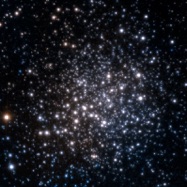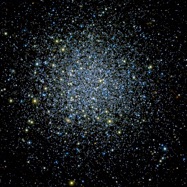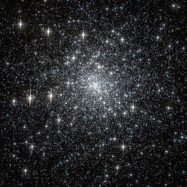






2015
A few heavy stars generated by stellar interactions are hidden in the core of ancient stellar systems made of millions lighter stars (with masses lower than that of our Sun). The Cosmic-Lab team has found a "cosmic scale" able to unmask these elusive "thin-looking fat" stars.
The Gemini Multi-Conjugate Adaptive Optics System (GeMS), in combination with the powerful infrared camera Gemini South Adaptive Optics Imager (GSAOI), reveals its potential in a series of striking images of the globular cluster Liller 1.


2012
2016
Two stellar populations with very different ages have been unveiled in the puzzling system Terzan 5: the oldest one formed back in the earliest days of the Universe, about 12 biillion years ago, while the second is only 4.5 billion years old. Terzan 5 therefore is a a site in the Galactic Bulge where recent star formation occurred. The fascinating conclusion reached by the international team of astronomers at Cosmic-Lab leadership is that Terzan 5 could be a living fossil from the early days of the Milky Way history, a crucial relic able to clarify how our galaxy formed.


2019
By studying the populations of Blue Straggler Stars in five and old globular clusters of the Large Magellanic Cloud, we have solved a 30-yr old dilemma: the differences in core radius observed for these systems is just the natural consequence of their internal dynamical evolution (which tends to make star clusters pregressively more and more compact), with no need of exotic populations of binary black holes.



2020
Two distinct stellar populations with remarkably different ages (the oldest one has an age of 12 Gyr, the youngest component is just 1-3 Gyr old) have been discovered in Liller 1, a stellar system in the Galactic bulge that was catalogued as a globular cluster since decades. This is the second object (after Terzan 5) discovered in the Bulge with such peculiarities, thus allowing the definition of a new class of stellar systems: the Bulge Fossil Fragments (BFFs). The properties of this class of objects suggest that they are the fossil remnants of giant stellar clumps that formed the Galactic bulge 12 Gyr ago, at the epoch of the Milky Way formation. Their existence demonstrates that also the Galactic bulge formed from the coalescence of sub-structures. The discovery has been published in Nature Astronomy.


2021
White Dwarf is the final stage of the evolution of the majority of stars in the Universe. Their ageing is generally described as a pure cooling process, during which they become cooler and fainter as function of time. HST observations demonstrated that not all White Dwarfs age at the same way. The compared investigation of the White dwarf population in two star clusters (M13 and M3, which share many physical properties such as total mass, age and metallicity) has revealed the existence of a population of slow cooling White Dwarfs. These stars have retained a thin hydrogen enevelope that allows them to still experience some additional stable thermonuclear activity, thus slowing down the rate at which they cool and age. This is the first evidence that stable hydrogen burning can indeed occur on the surface of these dying stars and change the definition itself of this final evolutionary stage of star life.


2022
The HST observations acquired within our project aimed at the exploration of the true nature of Bulge stellar systems have released on May 23, 2022 as HST Picture of the Week.


2023
The analysis of 320 high-resolution spectra acquired in 8 Galactic globular clusters with different structural characteristics revealed that the fraction of fast spinning blue straggler stars increases for decreasing central density of the host system. This suggests that rapidly rotating blue stragglers prefer low-density environments.


2024
The Physical Sciences section of the 2024, May 1st issue of the scientific dissemination magazine “Research Features” reports the story of the discovery of the Bulge Fossil Frangments.


Peering through the thick dust clouds of our galaxy central part (the so-called "bulge"), our team has discovered an unusual mix of stars in the stellar system known as Terzan 5. Never observed anywhere before in the bulge, this peculiar "cocktail" of stars suggests that Terzan 5 is not a genuine globulal cluster, but the relic of the bulge primordial building blocks. This fascinating discovery has been published in the prestigious journal Nature: Ferraro et al 2009, Nature, 462, 483 (a PDF copy of the preprint is also available at this address arXiv:0912.0192)
Two different types of "rejuvenated" stars have been discovered in the central region of the high-density cluster Messier 30 (M30). Stellar collisions and "vampirism" phenomena are thought to be the processes responsible for this cosmic "face lifting". The discovery is the result of a study performed by an international team of astrophysicists leaded by Francesco Ferraro of the Astronomy Department of the Bologna University and published in the prestigious journal Nature: Ferraro et al 2009, Nature, 462, 1028 (a PDF copy of the preprint is also available at this address arXiv:1001.1096).
The two major discoveries that motivated the Project
2009
Some people are in great physical shape at the age of 90, others appear old before they are 50. A new study demonstrates that this is true also for stellar clusters. In fact, despite their impressively large chronological ages of 12-13 billion years, stellar clusters can look more or less young. We have found a new clock able to measure the biological age of star clusters thus revealing their true "physical shape". This fascinating discovery has been published in the prestigious journal Nature: Ferraro et al 2012, Nature, 492, 393 (a PDF copy of the preprint is also available at this address arXiv:1212.5071)
You are free of downloading and using all the material (images, video,etc) reported in the press-releases.
We kindly ask you to report the following acknowledgment: "We made use of the products of the Cosmic-Lab project funded by the European Research Council."